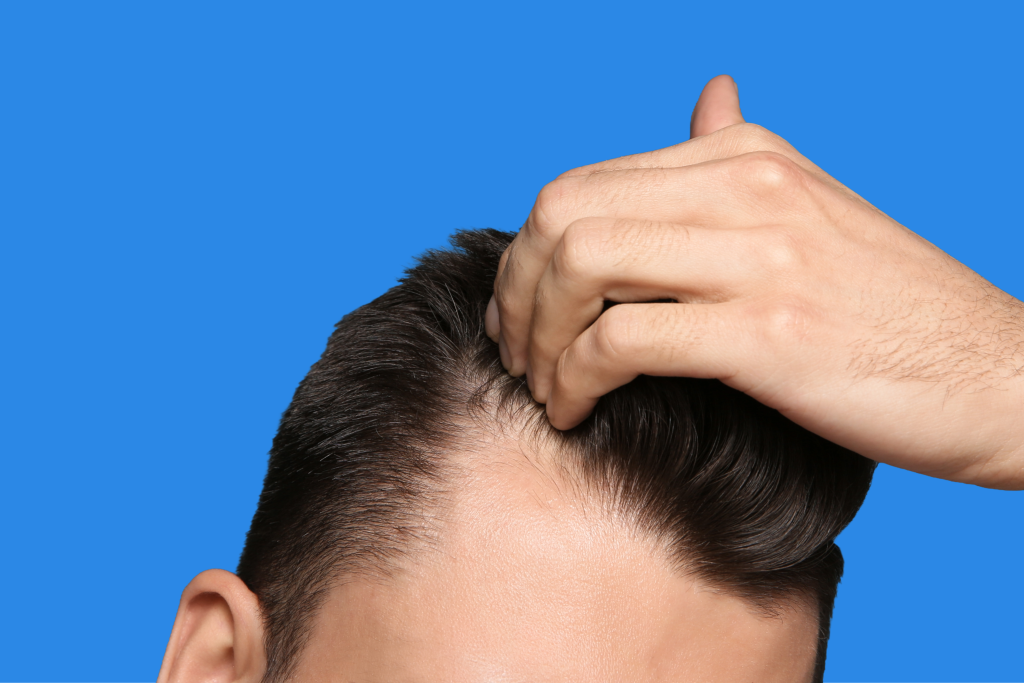See a provider online for same-day male hair loss treatment
$29 / message visit | $49 / video visit


What You Need to Do
Select Your Concern & Book
Choose your health concern (like hair loss or weight) and answer a few quick questions. Pick a time that works for you.
Meet Your Provider
Chat or video call with a licensed provider who will assess your condition and prescribe treatment if needed.
Get Your Treatment
Get care for common conditions—and if medication is needed, prescriptions can be sent directly to your pharmacy or delivered to your door (where available).
Get Ongoing Support
Stay connected with follow-up care to track progress and adjust your treatment if necessary.
What causes male pattern hair loss?
Male hair loss, or androgenetic alopecia, happens when hair follicles shrink over time—often due to the hormone DHT and genetics. This leads to thinning hair and a receding hairline.

Can men grow their back?
Yes, men can regrow hair if the follicles are still active. Treatments like minoxidil and finasteride can help regrow hair and slow loss, but results fade if you stop using them. There’s no permanent cure, and hair loss often progresses with age.
Is Pay-per-Virtual visit right for you?
-
You're between 18–64 years old
-
Your sex assigned at birth is male or you identify as transgender
-
You're experiencing typical male pattern hair loss—like a receding hairline or thinning at the crown
-
You haven’t lost more than 50% of your scalp hair
-
You're not losing hair elsewhere on your body
-
You're not experiencing scalp symptoms like pain, redness, sores, or scarring
Common Medications for male hair loss
An iVisitDoc provider will determine the most appropriate hair loss treatment based on your symptoms and medical history.
If prescribed, you can fill your medication at any pharmacy.
Note: Oral minoxidil isn’t available through iVisitDoc’s telehealth service.
Minoxidil (Rogaine)
Finasteride (Propecia)
Pro Tip
Start with lifestyle adjustments—like avoiding trigger foods, elevating your head while sleeping, and eating smaller meals. Medications work best when paired with healthy habits.
Quick virtual visits, anytime
Your questions answered
iVisitDoc Care & Access
What are your telehealth options for male hair regrowth treatment?
iVisitDoc offers virtual consultations with licensed providers who evaluate your hair loss symptoms and recommend treatment plans that may include FDA-approved options like finasteride or topical minoxidil.
Can I use my health insurance for iVisitDoc telehealth visits?
Some insurance plans may cover iVisitDoc visits or prescriptions. We recommend checking with your provider or pharmacy for coverage details.
What happens if a provider can’t diagnose or treat my hair loss through telehealth?
If your symptoms suggest a condition that requires in-person care or further testing, the provider will guide you to follow up with a local dermatologist or primary care provider.
Can I follow up with my provider after my treatment plan is delivered?
Yes. You’ll have the option to message your provider with questions about your plan or request follow-up care as needed.
What if I need to refill my hair loss medication?
If you’re eligible for a refill, you can request one easily through iVisitDoc. Your provider will review your treatment history before approving the renewal.
How does iVisitDoc protect my health information?
We follow strict HIPAA-compliant protocols to keep your health data private and secure. Your medical information is encrypted and stored safely.
About hair loss
How common is male pattern hair loss (MPHL)?
MPHL (also called androgenetic alopecia) is the most common form of hair loss in men. It affects about 50% of men by age 50, and up to 80% by age 70.
Is there a cure for male pattern baldness?
There’s no permanent cure. Treatments like Finasteride and Minoxidil can slow hair loss and promote regrowth if the follicles are still active. But if treatment is stopped, benefits are typically lost.
What’s the difference between finasteride and minoxidil?
Finasteride works by inhibiting the conversion of testosterone to DHT (dihydrotestosterone), a hormone that shrinks hair follicles.
Minoxidil works by increasing blood flow and stimulating the growth phase of hair follicles.
They have different mechanisms, routes of use, side effect profiles, and approved uses.
Can I get a prescription for oral minoxidil through telehealth?
Usually no — oral minoxidil is often considered “off‑label” for hair loss, and many telehealth services do not prescribe it due to monitoring requirements. Topical versions and standard treatments are more commonly available.
Can women or transgender individuals get hair loss treatment through telehealth?
Yes. While the specifics may depend on the telehealth service, many providers treat hair loss in transgender individuals and women — though some medications (like finasteride) may have different recommendations or restrictions depending on sex assigned at birth and other health considerations.
Clinical Sources
Prevalence of androgenetic alopecia in men: NICE CKS+1
Comparison of finasteride vs minoxidil: verywellhealth.com+1
